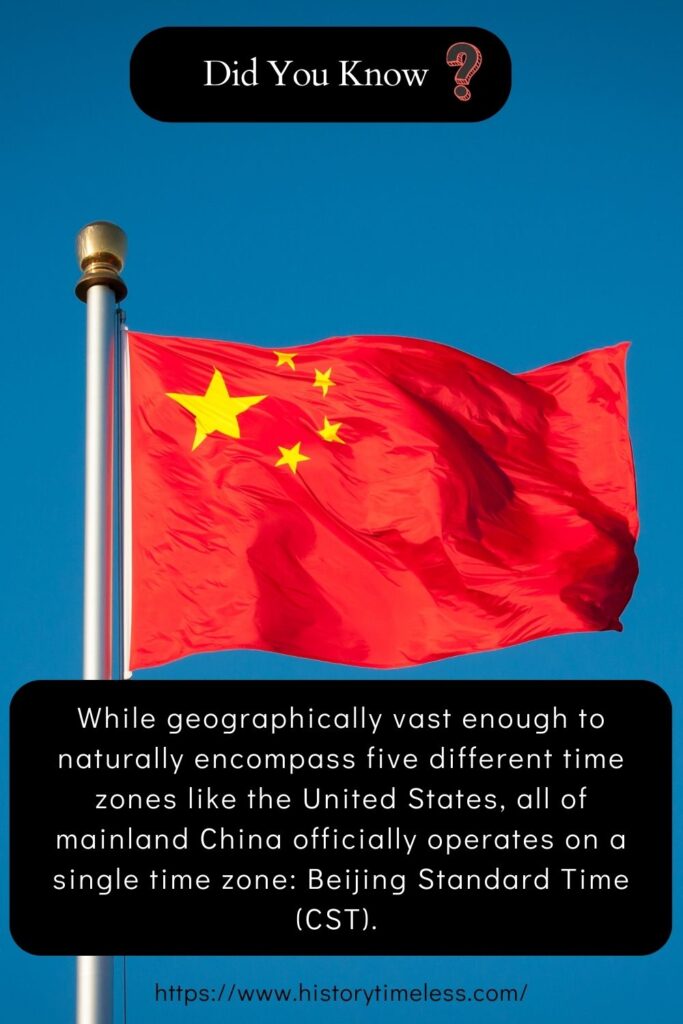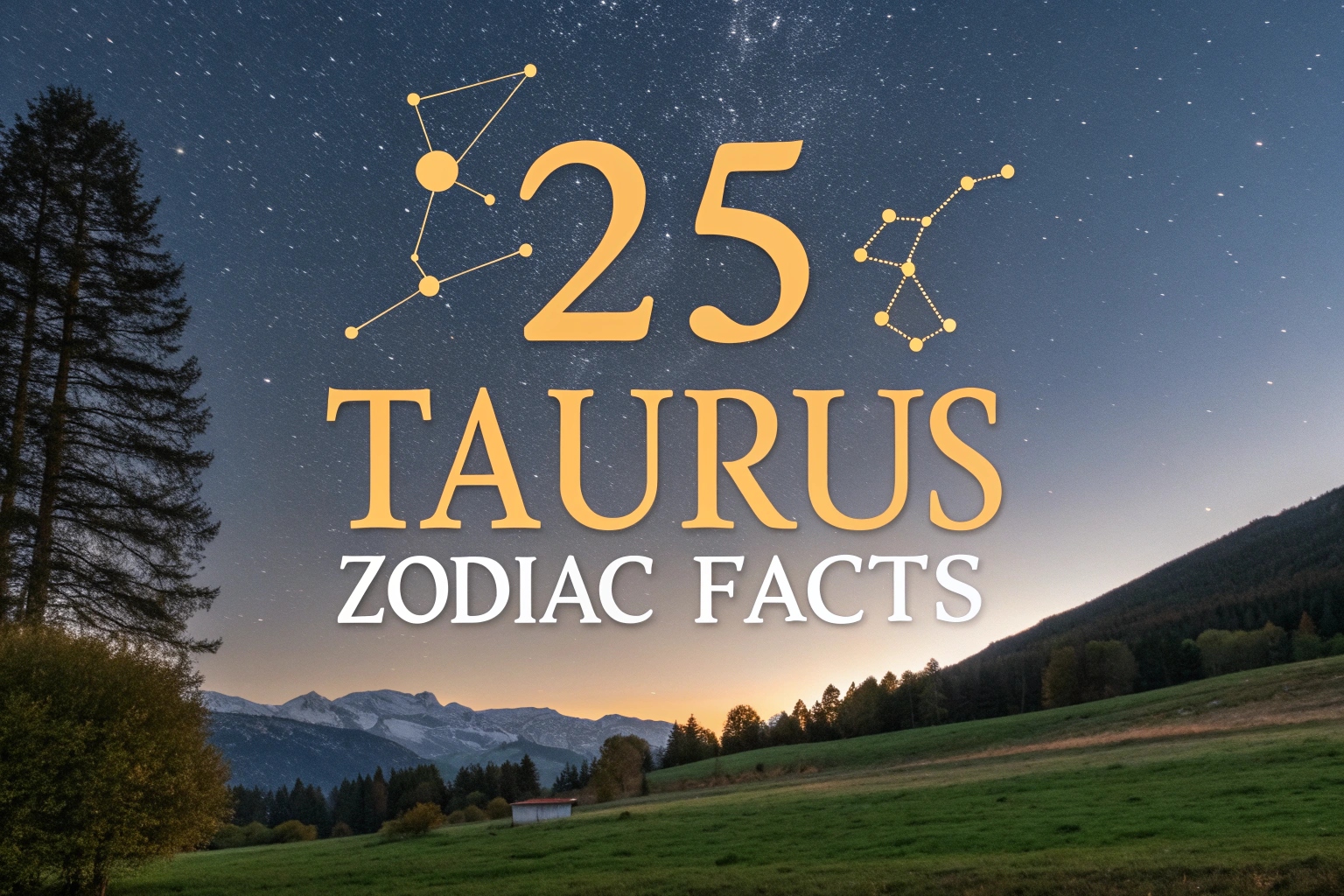Okay, great! Let’s explore the fascinating world of China with 8 captivating facts. China, a land of ancient wonders and modern marvels, holds a rich tapestry of history, culture, and innovation.
From its sprawling landscapes to its bustling cities, China offers a continuous source of intrigue and discovery.
Get ready to delve into some lesser-known yet captivating aspects of this global powerhouse and uncover the unique charm that makes China so compelling. Let’s embark on this journey of discovery together!
1. China’s Landscape Spans Five Geographical Time Zones Despite Using Only One
While geographically vast enough to naturally encompass five different time zones like the United States, all of mainland China officially operates on a single time zone: Beijing Standard Time (CST).

This unified time, established in 1949, is politically driven to promote national unity. Imagine the sunrise differences across the country!
In western regions like Xinjiang, the sun can rise as late as 10 AM local time, while in the east, it rises at a more typical hour. This single time zone policy creates some interesting daily life adjustments for people living in the far west of China, influencing work schedules and daylight hours.
2. Ketchup’s Surprising Chinese Origins Trace Back to ‘Fish Sauce’
Believe it or not, the condiment we know and love as ketchup has roots that stretch back to ancient China! The ancestor of ketchup was a fermented fish sauce called “ge-thcup” or “ke-tsap” in Southern Chinese dialects.
Traders brought this savory sauce to Southeast Asia, where it evolved. By the 17th century, British sailors encountered it in Malaysia and brought samples back to Europe. Early European versions experimented with ingredients like mushrooms, oysters, and walnuts.
It wasn’t until the 19th century that tomatoes became the dominant ingredient, leading to the sweet and tangy ketchup we enjoy today, a far cry from its salty, fishy predecessor.
3. Fortune Cookies Are Actually Not a Traditional Chinese Custom
Despite being synonymous with Chinese takeout in many Western countries, fortune cookies are surprisingly not a traditional custom in China itself.
While their exact origins are debated, they are most likely a Japanese-American invention from the late 19th or early 20th century, possibly evolving from Japanese crackers called “tsujiura senbei.”
They gained popularity in Chinese restaurants in the US during the early 20th century and became a staple of the American Chinese dining experience. Ironically, fortune cookies are now sometimes imported into China as a novelty item, demonstrating a curious cultural reversal!
4. The Terracotta Army Was Accidentally Discovered by Farmers Digging a Well
One of the most significant archaeological discoveries of the 20th century, the Terracotta Army, was unearthed entirely by accident. In 1974, farmers near Xi’an were digging a well when they stumbled upon fragments of terracotta pottery.
These fragments turned out to be parts of life-sized terracotta soldiers, part of the vast mausoleum complex of China’s first emperor, Qin Shi Huang.
This accidental discovery unveiled thousands of statues depicting soldiers, horses, chariots, and weaponry, buried for over 2,000 years. It remains a breathtaking testament to ancient Chinese craftsmanship and imperial power, all thanks to a quest for water.
5. China Consumes More Cement Than the Rest of the World Combined
China’s rapid urbanization and infrastructure development have led to an astonishing level of cement consumption. In fact, China uses more cement every three years than the United States used in the entire 20th century.
And even more incredibly, China currently consumes more cement than the rest of the world combined. This staggering statistic highlights the sheer scale of construction projects underway in China, from towering skyscrapers to extensive high-speed rail networks and massive dam projects.
It also raises environmental concerns due to the carbon emissions associated with cement production, prompting a push for more sustainable building materials.
6. Giant Pandas Are No Longer Classified as “Endangered” But Remain “Vulnerable”
In a positive conservation success story, giant pandas were officially reclassified from “endangered” to “vulnerable” by the International Union for Conservation of Nature (IUCN) in 2016.
This downlisting reflects decades of dedicated conservation efforts in China, including habitat preservation, captive breeding programs, and anti-poaching measures. While the wild panda population has increased, they are still considered “vulnerable” and face ongoing threats such as habitat loss and fragmentation.
Continued conservation efforts are crucial to ensure the long-term survival of these beloved creatures, and the reclassification is a testament to the progress made but not a signal to relax conservation efforts.
7. China Is Home to the World’s Largest Radio Telescope, Nicknamed “Sky Eye”
China boasts the world’s largest filled-aperture radio telescope, known as the Five-hundred-meter Aperture Spherical Telescope (FAST), or affectionately nicknamed “Sky Eye.”
Located in a natural depression in Guizhou province, this colossal telescope is designed to detect faint radio signals from distant galaxies and pulsars, pushing the boundaries of our understanding of the universe.
Its immense size and advanced technology allow it to probe deeper into space and detect weaker signals than any other radio telescope. “Sky Eye” represents China’s growing ambition and capability in scientific research and exploration.
8. The Number 8 is Considered Extremely Lucky in Chinese Culture
In Chinese culture, the number 8 is considered exceptionally lucky, and this belief permeates many aspects of life. The pronunciation of “eight” (bā) in Mandarin Chinese sounds very similar to the word for “prosperity” or “wealth” (fā).
This phonetic similarity has elevated 8 to a symbol of good fortune, success, and material wealth. You’ll see 8 incorporated into phone numbers, addresses, license plates, and even significant dates like the Beijing Olympics opening ceremony, which began at 8:08 PM on 08/08/08.
9. Tea Culture in China is Highly Ritualized and Varies Regionally
Tea is far more than just a beverage in China; it’s deeply ingrained in the culture and steeped in tradition. Tea ceremonies, particularly Gongfu tea ceremony, are elaborate rituals emphasizing respect, harmony, and tranquility.
Different regions specialize in various types of tea, each with its unique processing methods and flavor profiles. From the delicate green teas of Hangzhou to the robust black teas of Yunnan and the fermented Pu-erh tea, the diversity is astounding.
Tea houses are social hubs, and the art of tea preparation and appreciation is passed down through generations, making tea a cornerstone of Chinese hospitality and social interaction.
10. Paper Money Was Invented in China Over a Thousand Years Ago
While credit cards and digital payments dominate modern transactions, it’s fascinating to remember that paper money originated in China during the Tang Dynasty, over a thousand years ago.
Facing copper shortages, merchants in Sichuan began using paper receipts as promissory notes. The government soon recognized the convenience and in the 11th century, during the Song Dynasty, officially issued paper currency.
This innovation spread globally, revolutionizing trade and finance. China’s early adoption of paper money highlights its historical ingenuity and its pioneering role in financial systems long before the West.
11. Chopsticks Are Not Just Utensils, But Cultural Symbols with Etiquette Rules
Chopsticks, or “kuaizi,” are essential eating utensils throughout China and East Asia, but they are more than just tools; they are cultural symbols imbued with etiquette and meaning. Learning to use chopsticks is a rite of passage, and proper chopstick etiquette is crucial in Chinese dining culture.
Never stick chopsticks upright in a bowl of rice, as it resembles incense offerings at funerals and is considered extremely impolite.
Avoid using chopsticks to point or gesture, and don’t leave them crossed on the table. Mastering chopstick etiquette is a sign of respect and cultural understanding when dining in China.
12. The Great Wall of China is Not Visible from Space with the Naked Eye
Contrary to popular myth, the Great Wall of China is not visible from space with the naked eye. While it’s an incredibly long and impressive structure, from the vast distance of space, it’s simply too narrow to distinguish without magnification.
Astronauts in low Earth orbit, using powerful cameras, can sometimes photograph sections of the wall under ideal conditions of lighting and weather.
However, the notion of seeing it with the naked eye from the Moon or even from space stations is a persistent misconception. Its grandeur is best appreciated from Earth, where its immense scale becomes truly awe-inspiring.
13. China Has the World’s Largest High-Speed Rail Network and It’s Still Expanding
China has built the world’s most extensive and rapidly expanding high-speed rail network in just a couple of decades. Spanning tens of thousands of kilometers, this network connects major cities across the country, making travel incredibly efficient and comfortable.

Trains like the Fuxing Hao series reach speeds exceeding 350 km/h (217 mph), transforming long-distance journeys into swift and seamless experiences.
This massive infrastructure project has not only boosted domestic tourism and business travel but also showcases China’s technological prowess and commitment to modernizing its transportation systems.
14. Mandarin Chinese Has Four Main Tones, Dramatically Changing Word Meanings
Mandarin Chinese is a tonal language, meaning that the pitch or inflection of your voice when pronouncing a syllable can drastically change the meaning of a word. Mandarin has four main tones (plus a neutral tone), and mastering these tones is crucial for clear communication.
For example, the syllable “ma” can mean “mother,” “horse,” “hemp,” or “scold,” depending solely on the tone used. This tonal aspect can be challenging for language learners but also adds a musicality and nuance to the language.
Understanding and using tones correctly is essential to avoid unintentional and potentially humorous miscommunications when speaking Mandarin.
15. “Lost in Translation” Can Be Especially Real Due to Diverse Chinese Dialects
While Mandarin Chinese is the official language, China is incredibly linguistically diverse, with numerous dialects spoken across the country, some so different they are mutually unintelligible.
These dialects, sometimes referred to as “topolects,” vary significantly in pronunciation, vocabulary, and even grammar. Someone speaking Cantonese (common in Hong Kong and Guangdong) may not understand someone speaking Shanghainese or Sichuanese without significant effort or translation.
This linguistic diversity highlights China’s rich regional variations and can lead to genuine “lost in translation” moments, even amongst Chinese speakers from different areas. Mandarin serves as a crucial lingua franca to bridge these dialect gaps.
16. China is a Culinary Paradise with Eight Major Regional Cuisines
Chinese cuisine is renowned globally for its incredible diversity and flavors, and this stems from the existence of “Eight Culinary Traditions” or “Eight Great Cuisines” representing distinct regional styles.
These include Sichuan cuisine (spicy and bold), Cantonese cuisine (fresh and delicate), Jiangsu cuisine (refined and balanced), Zhejiang cuisine (light and fresh), Hunan cuisine (spicy and sour), Anhui cuisine (rustic and hearty), Fujian cuisine (seafood-focused and flavorful), and Shandong cuisine (savory and rich).
Each regional cuisine utilizes local ingredients, cooking techniques, and flavor profiles, resulting in a breathtaking array of dishes.
17. The Chinese Zodiac is a 12-Year Cycle of Animals Influencing Personality and Fortune
Beyond Western astrology, China has its own ancient zodiac system based on a 12-year cycle, with each year associated with a different animal: Rat, Ox, Tiger, Rabbit, Dragon, Snake, Horse, Goat, Monkey, Rooster, Dog, and Pig.
It’s believed that the year you are born in influences your personality traits, characteristics, and even your fortune. For example, those born in the Year of the Dragon are often considered ambitious and charismatic, while those born in the Year of the Ox are seen as dependable and hardworking.
The zodiac plays a significant role in Chinese culture, influencing everything from matchmaking to business decisions and New Year celebrations.
18. China is a World Leader in Mobile Payments, Largely Skipping Credit Cards
While credit cards are ubiquitous in many Western countries, China has largely leapfrogged this stage and become a global leader in mobile payments.
Platforms like Alipay and WeChat Pay are dominant, allowing people to pay for almost everything, from groceries and transportation to street food and online shopping, simply by scanning QR codes with their smartphones.
This rapid adoption of mobile payments has transformed daily life in China, making transactions incredibly convenient and efficient. The widespread use of mobile payments has also driven innovation in e-commerce and digital services, positioning China at the forefront of the cashless society movement.
19. Karaoke is Immensely Popular in China, a Favorite Social and Entertainment Activity
Karaoke, or KTV as it’s often called in China, is not just a pastime; it’s a cultural phenomenon. KTV lounges are incredibly popular and lavishly decorated, serving as social hubs for friends, families, and colleagues to gather, sing their hearts out, and enjoy each other’s company.
Unlike Western karaoke bars, KTV in China often involves private rooms where groups can sing in a more intimate setting.
It’s a ubiquitous form of entertainment, enjoyed by people of all ages and social backgrounds. KTV is deeply ingrained in Chinese social culture, reflecting a love for music, performance, and communal enjoyment.
20. China Has Vast Deserts, Including the Gobi and Taklamakan, Contrasting Lush Landscapes
While many associate China with rice paddies and mountains, a significant portion of the country is covered by vast deserts, showcasing its diverse geography. The Gobi Desert, known for its harsh conditions and dinosaur fossils, stretches across northern China and Mongolia.
The Taklamakan Desert, one of the world’s largest sandy deserts, lies in western China’s Xinjiang region, known for its shifting dunes and extreme temperatures.
These deserts present unique ecosystems and challenges, contrasting sharply with the fertile eastern regions. They highlight the incredible geographical diversity within China, from arid landscapes to lush forests and towering mountains.
21. Mahjong is a Complex Tile-Based Game with Rich Cultural Significance and Regional Variations
Mahjong is far more than just a game in China; it’s a deeply ingrained cultural tradition enjoyed by millions. This tile-based game requires skill, strategy, calculation, and a bit of luck.
Played with 144 tiles, the goal is to form sets and pairs to achieve “Mahjong” and win. Regional variations exist with different rules and scoring systems, adding to the game’s complexity and richness.
Mahjong is often played socially, bringing people together for hours of entertainment and friendly competition in homes, tea houses, and community centers throughout China.
22. China Experiences Earthquakes Frequently Due to its Location on Tectonic Plates
China is located in a seismically active region, positioned at the intersection of several major tectonic plates, including the Pacific, Indian, and Eurasian plates.
This geological setting makes earthquakes a relatively frequent occurrence in various parts of the country, particularly in western and southwestern regions. Throughout history, China has experienced numerous devastating earthquakes.
This seismic activity has shaped infrastructure development, building codes, and disaster preparedness strategies in earthquake-prone areas, highlighting the ongoing interaction between natural forces and human society in China.
23. The Chinese Writing System Uses Characters, Not an Alphabet, Each Representing Meaning
Unlike alphabetic writing systems, the Chinese writing system uses characters, where each character (or Hanzi) typically represents a word or morpheme, carrying meaning and pronunciation.
There are thousands of characters, and while literacy requires knowing a significant number, mastering even a few thousand allows for reading much of everyday text. Characters can be combined to form new words, and calligraphy, the art of beautiful handwriting using characters, is highly revered.
This logographic writing system is a fundamental aspect of Chinese culture and history, distinct from phonetic alphabets used in many other languages.
24. China is the World’s Largest Consumer of Pork, a Staple Meat in Chinese Cuisine
Pork is the most consumed meat in China, making the country the world’s largest pork consumer. Pork plays a central role in Chinese cuisine, appearing in countless dishes across regional styles.
From stir-fries and dumplings to braised dishes and roasted pork, it’s a versatile and widely enjoyed ingredient. Pork production and consumption are deeply intertwined with Chinese agriculture, economy, and culinary traditions.
The demand for pork significantly impacts global meat markets and agricultural practices, highlighting the scale and influence of Chinese dietary habits on a global level. Okay, just four more facts to round out our exploration of China!
25. China’s E-commerce Giant and the Spectacle of Singles’ Day Shopping Festival
China is home to the world’s largest e-commerce market, dominated by giants like Alibaba and JD.com. The scale of online shopping in China is truly staggering, particularly during the annual “Singles’ Day” (November 11th) shopping festival.
Originally started as a day for single people, it has morphed into the world’s biggest online shopping event, dwarfing Black Friday and Cyber Monday combined.
On Singles’ Day, billions of dollars are spent in just 24 hours, showcasing China’s incredible consumer power and the sheer scale of its digital economy. The festival highlights the innovative marketing and technological infrastructure driving China’s e-commerce revolution.
26. The Profound Importance of “Face” (面子) in Chinese Social Interactions
“Face,” or “mianzi” (面子), is a crucial concept in Chinese culture, deeply influencing social interactions and etiquette. It refers to one’s reputation, honor, dignity, and social standing, both individually and within a group.
Giving “face” to others, meaning showing respect and avoiding causing them embarrassment, is paramount. Similarly, “losing face” can be deeply shameful and detrimental to relationships. Understanding “face” is essential for navigating social and business situations in China.
It shapes communication styles, gift-giving customs, and conflict resolution, reflecting a culture that highly values harmony and social cohesion.
27. China’s Remarkable Rise in Green Technology and Renewable Energy
While historically associated with pollution, China is now making significant strides in green technology and renewable energy. Facing environmental challenges and seeking energy independence, China has become a global leader in solar panel manufacturing, wind turbine technology, and electric vehicle production.
Massive investments in renewable energy infrastructure are transforming China’s energy landscape. Cities are increasingly embracing electric buses and promoting green transportation.
This rapid shift towards sustainability demonstrates China’s commitment to addressing environmental concerns and becoming a major player in the global green economy, driving innovation and adoption of clean technologies.
28. Spring Festival: The Heart of Chinese Culture and Global Celebrations
Spring Festival, or Chinese New Year, is the most important and widely celebrated festival in China and across Chinese communities worldwide. Marking the beginning of the lunar new year, it’s a time for family reunions, elaborate feasts, vibrant decorations in red and gold, and traditional customs like giving red envelopes (hongbao) and watching lion and dragon dances.
The Spring Festival period involves weeks of preparation and celebration, culminating in the Lantern Festival. It’s a period of immense cultural significance, reflecting themes of renewal, prosperity, and family unity, and its global observance highlights the widespread influence of Chinese culture and traditions.
Dive Into More Fun Facts:
28 Fascinating Facts About Christmas You Probably Didn’t Know!
25+ Surprising Facts About Christianity You Didn’t Know!
20+ Insane Facts About Animals That Defy Belief!
15+ Interesting World Facts: Say ‘Wow’ to These Discoveries!




